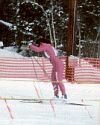The Curious Case of the Boulder Mountain Tour
March 19, 2019On January 27, 2018, something truly rare happened in the World Cup. In the women’s freestyle sprint final the field was closely packed coming into the finish, with Norway’s champion Maiken Caspersen Falla leading. But Sophie Caldwell of the USA and Laurien Van Der Graff of Switzerland had other plans -- they came up on opposite sides of Falla, passing her just before the finish line, with Van Der Graff declared the winner by 2/100ths of a second. Van Der Graff celebrated and is even interviewed about her victory.
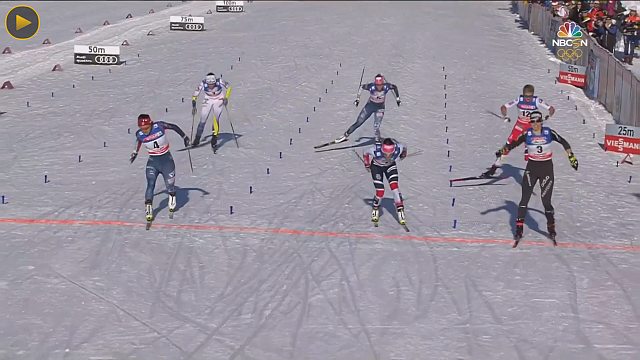
However, a review of the official finish line lynx camera eventually showed what most thought was impossible: a finish so close it was not possible to determine a winner. They adjusted the results and declared a tie! Two first place winners stood on top of the podium at the end of the day.
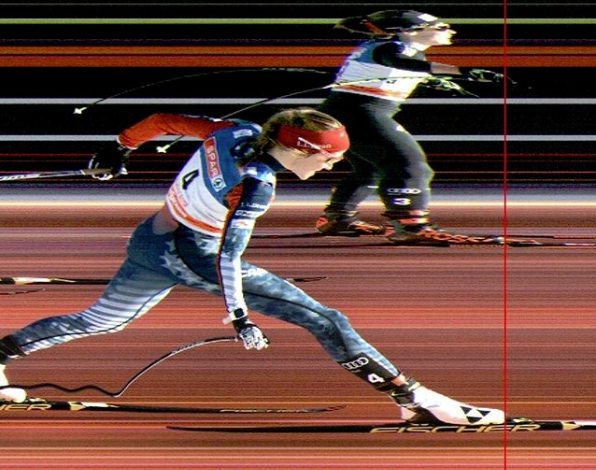
Flash forward to early February 2019. Matt Liebsch, an American Birkebeiner champion and Mora Vasaloppet champion (so many times you might need your hands and toes), co-owner of Pioneer Midwest and father of three, was out in Sun Valley, Idaho for a little altitude training and racing. Liebsch is still skiing near the top of his game, winning a SuperTour 10K freestyle race in mid-February and coming in third in a tight finish at the American Birkebeiner just a week later. So on Saturday, February 2nd, Liebsch entered the Boulder Mountain Tour.
The Boulder Mountain Tour is one of the oldest races in the Nation, with 2019 being the 46th edition. It is a point to point event starting at over 7400 feet and racing 34 kilometers down to 6250 feet, finishing just north of Ketchum, Idaho. There is prize money of $2500 to the winner, $1000 for second, and $500 for third -- plus two preems along the way that are worth $100 each. Some of the past champions include Audun Endestad, John Aalberg, Ben Husaby and Carl Swenson. In fact, Liebsch is a past champion, winning the event in 2012 by a mere three seconds over Lars Flora.
Sun Valley is also home to the Sun Valley Ski Education Foundation (SVSEF), one of the premiere training programs and race teams in the country.
The race went well for Liebsch. He stayed with a main pack that included Peter Holmes (SVSEF), Johnny Hagenbuch (SVSEF), Rogan Brown (Bridger Ski Foundation), Luke Brown (Bridger Ski Foundation), Adam Luban (SVSEF) and Bryan Cook (Salomon). Liebsch was frequently up front and even collected both preems along the way. As they came down to the final 200 meters, Holmes, Liebsch and Hagenbuch pulled ahead, with Holmes and Liebsch bringing the race right down to line for a stretch finish!
Liebsch was very excited and happy with his race, believing he had won. Liebsch said, “At the finish of the race I knew it was close. I felt it was within inches and I thought my lunge was better and I had better acceleration."
There was a lengthy delay in an announcement of the winner (more than 20 minutes). Eventually, Peter Holmes was declared the winner. A disappointed Liebsch stopped by the timing shack to view the evidence of the decision. The timing company, Sportstats, did have a FinishLynx camera setup along with an embedded red board finish line (a very similar setup to that used on the World Cup and other major races). However, one of the timing representatives told Liebsch that unfortunately the FinishLynx camera was not active at the time of the men’s finish. They had no image of the finish, thus said they were going to fall back to their chip timing which indicated Holmes came in first. Liebsch expressed his frustration with the result, felt he had no recourse, and so hit the road in order to make his connections for his flight back home.
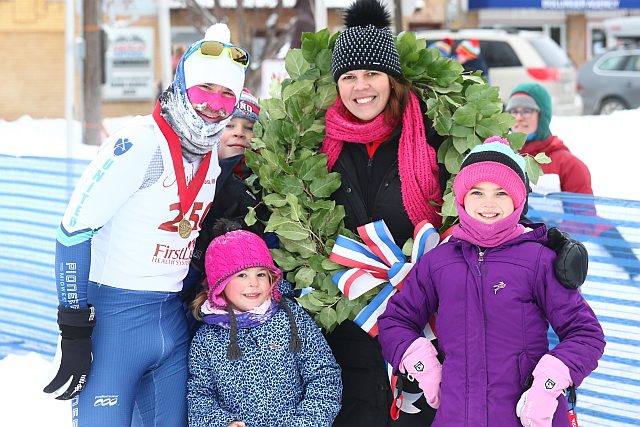
From there, the story begins to take some unusual twists. Liebsch, back home in the Twin Cities on Sunday reads an article from one of the local Sun Valley newspapers on the race and finds out the race was not decided based on chip timing, but rather the organizers used photographs from local photographer Nils Ribi to determine the winner. However, the article did not show the photograph that was used. On Monday, Liebsch contacted the race director, Jody Zarkos, to ask for the evidence they used to determine the winner. Zarkos told Liebsch via email that the Boulder Mountain Tour board of directors had asked her not to share the photo electronically. If someone wanted to see the winning photo, they would need to come to Sun Valley and view it in-person.
While not practical for Liebsch to travel to Sun Valley just to view the photo, he was fortunate to have a friend in the area, Bill Nurge. Nurge runs a Hardcore Training Center in Ketchum, ID, just down the road from Sun Valley. “I have known Bill since he came with me on my 2016 Haig Glacier Trip. We have stayed in contact often about equipment, coaching and technique and he was willing to host me of the week of the BMT,” stated Liebsch.
On Thursday after the race, Nurge was able to meet with Zarkos and was shown the winning photo on a computer screen. It was a photo by race photographer Nils Ribi, who appears to be standing several feet beyond the finish line as the skiers approach. When Nurge asked if he could have a copy, even offered to just take a picture of it, he was denied. What surprised Nurge the most about the photo was the finish line was not clearly showing, making it impossible to determine how the skiers boots lined up.
Nurge has been a tireless advocate for Liebsch on this, contacting a number of race officials and providing dozens of examples of where non-lynx photographs appear to show one result and official timing equipment proved a different result. While race officials acknowledged possible issues, they remained steadfast in their decision and considered the topic closed.
We contacted a number of people involved in the 2019 event, including the timing company, the race photographer and the Boulder Mountain Tour board of directors president. The timing company confirmed they did not have their FinishLynx camera operating in time for the men’s finish. Nils Ribi, the race photographer (who also works on the race organizing committee), referred all of our inquiries on the finishing photos to the board of director president Andy Munter. However, when we passed along the article where it was stated the race officials used his photos to determine the winner, Ribi stated that was the first he had heard of it.
Munter reached out to us directly, and was generous with his time in discussing the matter. He expressed his regret that the timing system they had hired did not acquire the proof typically required to determine photo finishes. But he said a number of board members, many with extensive experience, had all reviewed the winning photo and felt confident the photo showed Holmes had won the race. However, Munter reiterated his position that they did not feel comfortable releasing the photo out onto the Internet. He did say they discussed the possibility of a tie, but felt the photo gave them a clear winner. At the same time, he conceded it was possible they may have made a mistake but stated the board’s decision on the winner was final.
Liebsch remains frustrated by how the situation was handled, especially the lack of disclosure in the evidence used to prove he lost. Despite repeated attempts, Liebsch has still not been shown the photo by the race organization. While he certainly could have appreciated the extra money that would have come with first place, he would have been satisfied had they simply decided to call the race a tie.
On YouTube, there is a video that is a photo montage of the 2019 Boulder Mountain Tour created by Nils Ribi, the race photographer. In the video, there are three photos that show the skiers approaching finish (starting at 5:20), although it is unclear where exactly the finish line is. According to Nurge, the photo he was shown by the race director can be viewed at 5:35 in the video:
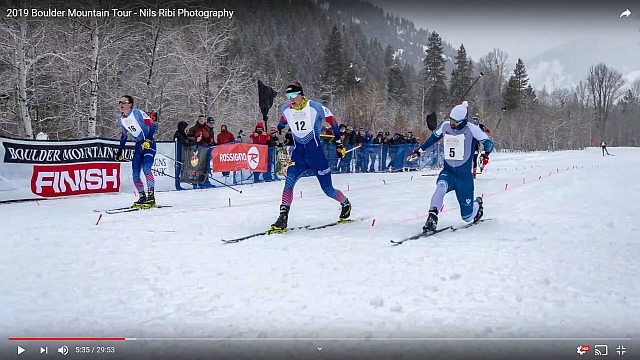
We may never know the full story without seeing the official evidence used to make the call. But it is worth noting back in 1978, the Boulder Mountain Tour did declare a tie for first place and, as recently as 2016, they have had ties in age class awards.

